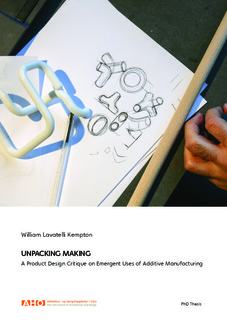Unpacking making : a product design critique on emergent uses of additive manufacturing
Doctoral thesis
Submitted version

View/
Date
2019Metadata
Show full item recordCollections
- Design [33]
Abstract
In recent decades, designers have applied 3D printers as Rapid Prototyping (RP) tools for developing design ideas. Today, as technical capabilities are advancing, these tools are finding newfound uses within design practice as an Additive Manufacturing (AM) technology. Similarly, technical advances are shifting AM towards consumer use. This thesis sees a need to compliment technical capabilities of AM such as customisability, enhancement and computation through a research by design based inquiry located in product design. Through such a practice-led mode of research, it argues that AM needs to be supported by critical reflection of its technical capacities, as they are subjected to interpretation through contexts of use.
In the context of product design, the project of the thesis is to tackle this need for sociotechnical perspectives in AM. It does so through investigating the relationship between design, making and critique. As the title suggests, unpacking making plays a central role in accessing topics of research, through its engagement with practice and in generating knowledge. These research topics cover the emergence of AM, product design expertise and technological critique. The study applies methods and processes from within design and making to generate knowledge around the emergence and use of AM. I connect this emergent use to my own constructive design practices, where I have developed novel 3D printing processes, as well as through observing expert- and prospective design-practitioners. This mode of inquiry is supported by critical design approaches, such as critical making. Together they situate the study within design pedagogy and critique.
In the mode of a thesis by compilation, I develop a holistic model of design- making critique in which product design is oriented towards critical and future-oriented forms of inquiry. With making as a core and integrating activity, the model moves from design-making critique through emergent use groups, into a wider technological design frame. The model is positioned with respect to the diverse means, context, tools and memberships in which making is made manifest. The model has the potential to contribute to design practice as a tool for technological reflection.
The study makes the following overarching contributions. Firstly, it critiques the sociotechnical transformation of AM from within the product design field. Secondly, it incorporates theories of socio-technological development into design pedagogy. Thirdly, it realigns critical making approaches to design expertise. For design practitioners, the study may also be useful for generating insight into the technical materials of AM, and in applying them in contextual design processes.
